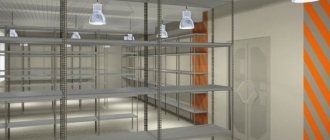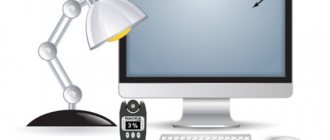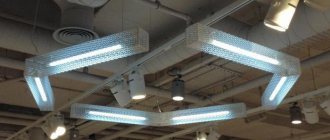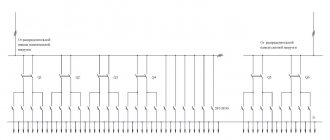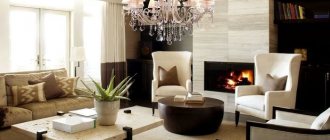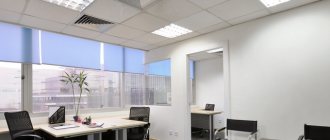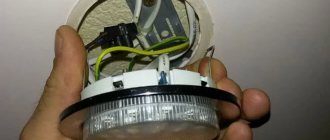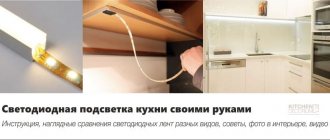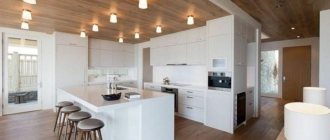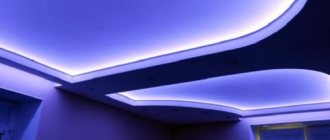Lighting devices are used everywhere. It’s hard to imagine the modern world without them, so there are many varieties that differ in design, features of use and other parameters. At the same time, all types of home equipment have common features, which allows them to be grouped and divided into categories.
Several types of lamps can be used in one room.
Lighting device design
The design of any lighting device includes:
- parts of the electrical wiring intended to connect the device to the circuit;
- fittings are needed for fastening and protecting an artificial light source from mechanical damage and exposure to external factors (moisture, water, pressure, ultraviolet). Includes decorative elements and details designed to diffuse the flow of light;
- Light source;
- fasteners for installation.
Classification of lighting fixtures
Equipment can be divided into different groups according to several criteria. They differ not only in design features, but also in operating parameters, as well as the degree of security.
Classification by place of application
Lighting devices are used almost everywhere. Therefore, during manufacturing, the conditions of use are taken into account; in total, three application options are distinguished:
- Indoors. The most common group, used in the residential and industrial sectors, as well as in public buildings. There are many options, from traditional chandeliers and recessed lights to table lamps and different types of lighting. The level of protection from adverse conditions varies, since devices are often installed in rooms with high humidity.
- In open spaces. Here the requirements are much higher, since the equipment is affected by precipitation, temperature changes and other unfavorable factors. This group includes all devices that are installed outdoors and in unheated rooms.
Street lights must withstand precipitation and temperature changes. - In extreme environments. It is often necessary to install lamps underwater, in mines, in the Far North, in places where there is a danger of stones, etc. Most often, lamps are designed for specific conditions.
Options for open space can also be used indoors, but the opposite should not be done.
Classification according to environmental protection level
The degree of protection is indicated by the letters IP and is present in almost all equipment. Therefore, when choosing, you need to pay attention to the labeling; there are several main types:
- IP20 . The lowest class, which protects the light source only from large elements. The equipment is suitable for residential and heated premises and does not withstand the ingress of water and other adverse influences.
- IP44 . Option with normal moisture protection. It can be used both for outdoor lighting and in rooms with high humidity. At the same time, splashing water is also undesirable.
- IP54-IP65 . Options with excellent protection from dust and moisture can be used in almost any environment. They withstand direct water jets and do not allow even fine dust to enter the housing.
- IP68 . Suitable for difficult operating conditions, can be installed even under water.
Options with the highest degree of protection can be installed even under water.
Classification of indoor luminaires by design
This is the largest group, with dozens of varieties. There are several main ones:
- Hanging. They are located at some distance from the ceiling and can be mounted on a rigid leg or a flexible element (cord, chain, etc.). The second type is convenient in that you can adjust the height of the location. Chandeliers can have different sizes and shapes.
- Built-in. Suitable for hollow structures, most often installed in suspended and plasterboard ceilings. The body is located in a niche, only the outer part is visible from the outside, most often it is a diffuser or an adjustable lampshade. There are semi-overhead options, they are partially hidden under the ceiling.
Built-in options are ideal for suspended ceilings. - Wall lights. These can be classic sconces or more modern options with the ability to change the direction of the light.
- Table and floor lamps. The first type is placed on the tabletop or attached to its end with a special clamp. The second is floor lamps, placed near a sofa or armchair to provide comfortable conditions for reading.
- Built-in panel elements. Used in suspended ceiling systems made of slabs. The size fits standard cells, so they are easy to install and look neat.
- Ceiling lamps. Most often they are small in size and evenly distribute light around due to the diffusing element. A modern variety is LED panels.
LED strips can be used not only as decorative, but also as main lighting if you place several rows in a box with a diffuser.
By type of lamps used
Several main types are used in lamps, the most common are:
- Incandescent lamps. An inexpensive solution that is used less and less due to high energy consumption.
- Luminescent models are characterized by low energy consumption and good luminous characteristics.
- Halogen ones provide high-quality light, but consume a lot of electricity.
- LEDs are the most economical today. They provide even light and last many times longer than analogues.
Video on the topic: Types of lighting lamps.
Choosing a lighting device is not difficult if you take into account the operating conditions and the desired level of illumination. To achieve the best effect indoors, it is worth combining different types of equipment.
Classes of devices for creating artificial light
Description of the three main types of artificial lighting devices:
- spotlight – allows you to concentrate light beams in small solid angles. Designed for illuminating objects located at a great distance from the light source. For example, stadium lighting or high-beam car headlights;
- lamp - distributes the main flow of light from the device within large solid angles. The distance to the object should be commensurate with the size of the lighting device used. Installed for lighting both large and small objects;
- projector – distributes the entire light flux evenly. Installed to illuminate a strictly limited surface. Performance characteristics are ensured by the operation of a complex system of mirrors and lenses. The device falls into the category of lighting devices, but is mainly used for presentations. Not used for lighting in the usual sense.
Spotlights
Exposure spotlight - a lighting spotlight for illuminating individual objects in a room.
General Purpose Floodlight - A lighting floodlight for illuminating large open spaces and surfaces.
Accent lighting spotlight is a general purpose spotlight for illuminating monuments, building fragments and other similar objects.
Searchlight - a lighting spotlight for searching for objects.
Headlight is a spotlight installed on vehicles and designed, as a rule, to illuminate the road in the direction of travel.
Outdoor lighting equipment: classification
External lighting can be:
- utilitarian (part of the complex for traffic safety);
- artistic (installed as a means of attracting attention to a specific object, installed to illuminate facades, architectural buildings, used as decorative elements).
Depending on the goals, the design and characteristics of lighting equipment and the lighting system equipment itself will change.
Lighting
General lighting - general lighting of indoor and outdoor spaces.
Local lighting - local lighting of work surfaces.
Utilitarian outdoor lighting is outdoor lighting designed for
ensuring safe and comfortable movement of vehicles and pedestrians.
Functional and decorative lighting - outdoor lighting designed
to create a safe, comfortable and aesthetic environment mainly for pedestrian areas (sidewalks, parks, squares, landscapes, etc.).
External lighting equipment is divided into the following subtypes:
- light source - the group combines various types of artificial light devices;
- lighting fixtures - several parts necessary for the proper functioning of the light source (there are many varieties);
- additional functional elements - used to distribute the light flux at a given angle, in the required color range and required intensity. This also includes various devices for mounting lighting devices;
- control units - software and hardware, a system that ensures uninterrupted operation of lighting equipment;
- protective system and safety elements - parts and systems that ensure the safe operation of lighting fixture systems, elements that prevent the negative impact of the external environment on the equipment.
Elements of lighting fixtures
The reflector of a light device (reflector, lampshade) is an element of the optical system of a light device that redistributes the light of the lamp in accordance with the law of light reflection.
A mirror reflector of a light device is a reflector of a light device that redistributes the light of the lamp in accordance with the law of specular reflection of light.
A frosted reflector of a light fixture is a reflector of a light fixture that redistributes the light of the lamp in accordance with the law of directionally diffuse reflection of light.
Diffuse reflector of a lamp - a reflector of a lamp that redistributes the light of the lamp in accordance with the law of diffuse reflection of light.
A counter-reflector of a light fixture is a mirror reflector installed near the lamp on the side of the output hole, preventing the direct output of light from the lamp and directing the light flux incident on it to the reflector of the light fixture.
The plate reflector of a light fixture is a mirror reflector consisting of several mirror-reflecting flat plates.
The diffuser of a light device (lampshade) is an element of the optical system of a light device that redistributes the light of the lamp based on the laws of diffuse transmission of light.
Diffuse lamp diffuser - a lamp diffuser that redistributes the light of the lamp in accordance with the law of diffuse light transmission.
Matte lamp diffuser is a lamp diffuser that redistributes the light of the lamp in accordance with the law of directionally diffuse transmission of light, while light scattering occurs in the volume of the diffuser material.
Frosted light fixture diffuser is a light fixture diffuser that redistributes the light of the lamp(s) in accordance with the law of directional scattered transmission, with light scattering occurring on the surface of the diffuser.
The refractor of a light device is an element of the optical system of a light device that redistributes the light of the lamp in accordance with the law of refraction.
The lens diffuser of a spotlight is a set of lenses that, when acting together with other elements of the optical system and the lamp, provide the required light distribution of the spotlight.
The shielding grille of a light device is an element of the optical system of a light device, consisting of opaque or light-transmitting screens that, when combined, create a specified protective angle.
The housing of a light fixture is a part of the lighting fixtures that serves as a base for attaching the remaining parts.
Protective glass of a lighting device is an element of the lighting fixtures of a lighting device made of light-transmitting material to protect the lamp and the current-carrying part from environmental influences or mechanical damage.
The light-transmitting shell of a light device is a set of elements of the lighting fixtures of a light device through which light comes out and simultaneously serves for mechanical protection.
| Classification of luminaires according to the type of luminous intensity curve | Zone of directions of maximum luminous intensity | luminous intensity curve shape coefficient Kf | |
| Name | designation | ||
| concentrated | TO | from 0 to 15° | Kf ≥ 3 |
| deep | G | from 0 to 30° | 2 ≤ Kf< 3 |
| cosine | D | from 0 to 35° | 1.3 ≤ Kf< 2 |
| semi-wide | L | from 35 to 55° | 1.5 ≤ Kf< 1.9 |
| wide | Sh | from 55 to 85° | 1.9 ≤ Kf< 2.3 |
| uniform | M | from 0 to 90° | Kf ≤ 1.3 at Imin> 0.7 Imax |
| sinus | WITH | from 70 to 90° | Kf> 1.3 at I0< 0.7 Imax |
I0 - luminous intensity value (cd) in the direction of the optical axis of the lamp (0o)
Imin is the minimum luminous intensity, the value of which is selected among the measured ones
luminous intensity values for a given plane
Imax—maximum luminous intensity, the value of which is selected among the measured ones
luminous intensity values for a given plane
Iav is the average luminous intensity, the value of which is calculated as the average intensity
light for the same plane
Kf = Imax/ Iaver
Lamps with luminous intensity curves that do not correspond to the characteristics specified in
table, are classified as lamps with a special distribution of luminous intensity.
Types of lighting equipment (for outdoor lighting)
The classification of light sources of outdoor lighting systems is determined by the lamps used. Read about the types and types of lighting sources in this article. Sources differ in brightness, power, service life, and light spectrum.
A lighting device is selected for each specific light source:
- spotlight – has an increased brightness indicator, high beam density. Installed for lighting high-rise structures. Often used as a decoration element;
- A lamp is a group of devices with many subgroups, varying in size, functionality, and method of fastening.
LAMPS FOR LIGHTING SYSTEMS
According to the type of light source, the artificial electric lighting system is divided into the following types:
Incandescent lamp (LON).
One of the first and most widely produced light bulbs. Light is produced by the passage of electricity through a tungsten wire and its subsequent incandescence. No more than 5% of electricity is converted into light, the rest is spent on heat generation. Emits yellow light, service life rarely exceeds 1000 hours. Popular because of its affordable price;
Metal halide lamp (MHL).
It is a high pressure gas discharge lamp. Light is produced by ions in gas halides of certain metals. To operate, you need a pulse ignition device (IZU) and a choke (ballast). Service life is about 15 thousand hours. The efficiency of converting electricity into light is 20-25% higher than that of incandescent lamps.
Among the disadvantages, it should be noted the high cost and long combustion time (30 seconds - 3 minutes). In addition, they cannot be turned on again until the lamp cools down.
Mercury halogen lamps (MRL).
Light is produced by an electrical discharge in mercury vapor. Technically, they are completely similar to metal halogen lamps. Service life up to 10 thousand hours, light output up to 55 lm/W. There is sensitivity to low temperatures and a long combustion time, which can reach 10 minutes.
One of the varieties of DRLs are mercury-tungsten lamps (HMW) in their bulb, in addition to mercury vapor, there is also a tungsten filament. Such lamps can be used without ballast and IZU, but have a much shorter service life - up to 4000 hours, as well as low light output efficiency of up to 30 lm / W.
Sodium lamps (HPS).
They also belong to the class of gas-discharge lamps; the glow is formed in sodium vapor. They emit yellow-orange light, because of this, despite their high efficiency, light output (150 lm/W), they have a limited scope of application. Economical, service life reaches 30 thousand hours.
Full startup requires up to 7 minutes. Often used in industries that require round-the-clock lighting, for example, in greenhouses.
Compact fluorescent lamps
(CFL) (energy-saving fluorescent lamps).
As a rule, they have a spiral-shaped radiating element on a plastic base, where the inductor and IZU are located, which ends with standard E14/27/40 sockets.
Light-emitting diode lamps (LED).
They are the most economical of all those existing today. The service life is about 30 thousand hours, and energy consumption is 10 times lower compared to classic incandescent lamps. They do not contain mercury and are available in almost all color variations. The only drawback is the rather high price of the devices.
Lamp - areas of application
The design of the lighting device and functionality directly depend on the scope of application of the lamp:
- console – make it possible to simultaneously use several light sources;
- suspended – can be suspended on a flexible cable;
- crowning - mounted on low supports, used to illuminate pedestrian areas, paths, sidewalks;
- wall and floor - used both in artistic and utilitarian lighting complexes.
Lighting device design
Regardless of the type and purpose of use, the design always consists of several main parts:
- Light source. This can be either a replaceable lamp or built-in LEDs. Power directly depends on this element. Often you can replace the light bulb with a more powerful one, or vice versa, which allows you to provide the desired quality of light.
- Lighting fixtures. It includes a housing, a diffuser or reflector and a socket in which the light source is installed. The design varies, it all depends on the type of equipment and the requirements that are placed on it. At the same time, the design must comply with safety standards, they are prescribed in GOST and TU.
- Starting equipment. Ensures optimal operating conditions and prevents the lamp from burning out during startup. Not available in all lamps, since some light sources do not require a ballast.
- Protection and control devices. There can be many options here, since now lighting systems are often included in the Smart Home complex, etc.
- Wiring. Voltage is supplied through it and selected according to the characteristics of the light source and the installation location of the structure. Sometimes the equipment can be battery powered (emergency lighting) or solar powered.
The components of different types of lamps are the same.
By the way! Often, lighting devices are combined with light or motion sensors to be turned on by a signal.
Types of lighting equipment
Lighting equipment can be lanterns, lamps, various lamps, and spotlights.
Lighting devices can vary in the effect they produce:
- spot lighting (directional lighting);
- blurry lighting (scattered light);
- creating various lighting effects.
Professional lighting instruments include:
- color changers;
- scanners;
- rotating heads;
- gobo spotlights;
- anti-aircraft searchlights;
- lasers;
- LEDs. Read about the use of LED lighting here.
Light complexes
A lighting complex is a device consisting of a set of lighting devices, individual light-redistributing or light-converting elements, structural, electrical and other parts, assembly units or blocks, assembled from the consumer, performing its functions only in assembled form and intended for lighting or signaling.
A luminous strip is a light complex, the ratio of the length of the luminous surface to its width is more than 5.
A luminous ceiling is a lighting complex, the dimensions of the luminous surface of which are comparable to the dimensions in terms of the illuminated room.
A slot light guide is a hollow, extended cylindrical or other shaped light-redistributing element of a light complex, most of the inner surface of which along its entire length is covered with a specularly reflective layer, while the luminous flux of the lamp is introduced into the end of the light guide and exits it along its entire length through that part of the surface that not covered with a reflective layer - a light-transmitting optical slit.
About the importance of lighting technology
Light and sound accompaniment of events is a component of the action itself and a necessary part of the atmosphere of the event. For example, light is important for the work of artists on stage and their visibility from the audience.
It is important to have enough street lighting for driving on the road. Illumination of roads, sidewalks and public areas is a necessary part of everyday life in the city. The light will make it convenient to stay on the street at night and increase the level of safety on the roadway.
Lamps
General lighting lamp - a lamp for general lighting of rooms and open spaces.
Local lighting lamp - a lamp for local lighting of work surfaces.
Night light is a lamp designed to create the lighting necessary for orientation in a room at night.
An exposure lamp is a lamp designed to illuminate individual objects.
A chandelier is a multi-lamp pendant lamp for general lighting for residential or public spaces.
A dockable luminaire is a luminaire whose design allows it to be installed in a line and electrical network wires to be laid through it.
A standard luminaire is a luminaire in which the lamp and the current-carrying part are not protected from dust and water.
A lamp for interior lighting (a lamp for residential premises, a lamp for public buildings, a lamp for industrial premises) - a lamp for general and local lighting of apartments in residential buildings, public and industrial premises.
Decorative lamp is a lamp that is mainly an architectural element of the interior and plays a limited role in creating the necessary lighting conditions.
Lamp for outdoor lighting - a lamp for illuminating streets or squares.
Artificial lighting
Since ancient times, man has learned to illuminate his home with the help of fire. Over time, civilization developed, and with the invention of electricity, artificial lighting gradually became available to every home or industry. To implement the correct system in a space, several types of lighting lamps are used - incandescent, fluorescent or LED.
Artificial light comes in several types; let’s take a closer look at each of them.
General. Uniform illumination of the space is achieved by distributing ceiling lights at equal distances throughout the entire area. Ceiling lamp voltages are typically the highest voltage available on the market. Production premises are illuminated with fluorescent lamps located on the ceiling. This method ensures the normal indicators necessary for the safe work of employees at the enterprise. In residential premises, general light is localized, as a rule, in the center of the ceiling. In large houses, ceiling lighting is distributed evenly over several lamps, and modern trends recommend distributing overhead artificial lighting at several levels.
Local . The most comfortable lighting is considered to be local or local. The source is installed directly close to the work area, for example above the dining table, hob, or kitchen sink. For the hallway of a room, a local lamp can be near the mirror, above the hanger, at the front door. Each room in the apartment requires its own arrangement of lamps, for example, for a bedroom it would be appropriate to hang small wall sconces on the sides of the bed; in the living room, such an area becomes a soft corner or a desk with computer. As a rule, local light operates in a narrow zone of directional flow.
Local lighting.
Combined. For both residential premises and industrial buildings, it would be the best option to equip both types in order to be able to use all the methods of available artificial lighting. Thus, several problems will be solved: the space will be illuminated by diffuse artificial light from the ceiling, and for some types of work, a directed artificial flow will be used, only if necessary.
Advice : If you are planning several types of lighting, then try to complete the electrical wiring project before starting the renovation.
Main types of artificial lighting
Modern technologies make it possible to conduct normal life activities at different times of the day, thanks to artificial lighting sources that allow you to adjust the level and direction. All types of systems are distinguished by functionality and location in space. Let's take a closer look at each option.
For industrial production, the classification of artificial lighting is divided into working, emergency (for safety and evacuation), as well as security and duty.
Work - provides the necessary level of artificial lighting to perform work duties in production or at home in the workshop, kitchen, library, at the desk;
Working lighting.
Emergency - for industrial, office and medical institutions, emergency switching is provided, which is automatically triggered during power outages. This type is powered by a special generator, which is turned on when necessary.
Some strategically or socially important enterprises have an additional backup source of artificial power. Emergency artificial light is usually divided into safety (turned on when backup power is needed) or evacuation (used towards the main or emergency exit);
Definitions of the type of emergency light
Security - located around the perimeter of the entire protected area, and is usually used only in the dark;
Duty duty - used for non-working hours, and its intensity is not standardized and depends on specific tasks (for example, for staircases or corridors);
In history, artificial lighting is usually divided into: general, accent, local and decorative.
General – usually understood as the presence of ceiling lights or chandeliers;
General lighting.
Accent - used to highlight a specific area of the room, for example, a soft corner for the living room or a space next to the hallway hanger; in sales areas, accent artificial light helps increase product sales;
Local - called local light, used to improve visibility in the workplace, for example a kitchen or computer desk;
Decorative - used to decorate the space of a home, shop windows, during a holiday, or if the design idea provides for such a decorative technique using lamps of different colors and shapes.
